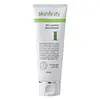What's inside
What's inside
 Key Ingredients
Key Ingredients

 Benefits
Benefits

 Concerns
Concerns

 Ingredients Side-by-side
Ingredients Side-by-side

Water
Skin ConditioningLaureth-1 Phosphate
Dipropylene Glycol
HumectantAcrylates Copolymer
Lauryl Phosphate
EmulsifyingGlycerin
HumectantCocamidopropyl Betaine
CleansingPPG-3 Caprylyl Ether
SolventCitric Acid
BufferingDimethyl Sulfone
SolventAllantoin
Skin ConditioningHydroxyacetophenone
AntioxidantButylene Glycol
HumectantMyrtus Communis Extract
AstringentTropaeolum Majus Extract
AntimicrobialEthylhexylglycerin
Skin ConditioningSalix Alba Bark Extract
AstringentPyridoxine Hcl
Skin ConditioningAlanine
MaskingArginine
MaskingGlycine
BufferingGlutamic Acid
HumectantSerine
MaskingSciadopitys Verticillata Root Extract
AntimicrobialDipotassium Glycyrrhizate
HumectantHouttuynia Cordata Extract
Skin ConditioningCopper Tripeptide-1
Skin ConditioningParfum
MaskingWater, Laureth-1 Phosphate, Dipropylene Glycol, Acrylates Copolymer, Lauryl Phosphate, Glycerin, Cocamidopropyl Betaine, PPG-3 Caprylyl Ether, Citric Acid, Dimethyl Sulfone, Allantoin, Hydroxyacetophenone, Butylene Glycol, Myrtus Communis Extract, Tropaeolum Majus Extract, Ethylhexylglycerin, Salix Alba Bark Extract, Pyridoxine Hcl, Alanine, Arginine, Glycine, Glutamic Acid, Serine, Sciadopitys Verticillata Root Extract, Dipotassium Glycyrrhizate, Houttuynia Cordata Extract, Copper Tripeptide-1, Parfum
Water
Skin ConditioningPropanediol
SolventGlycerin
HumectantAvena Sativa Kernel Extract
AbrasiveSqualane
EmollientBetaine
HumectantGluconolactone
Skin ConditioningSalicylic Acid
MaskingPEG-6 Caprylic/Capric Glycerides
EmulsifyingSodium Lauroyl Oat Amino Acids
CleansingPanthenol
Skin ConditioningZinc PCA
HumectantAllantoin
Skin ConditioningAlpha-Glucan Oligosaccharide
CleansingXylitol
HumectantCoco-Glucoside
CleansingAloe Barbadensis Leaf Extract
EmollientLaminaria Ochroleuca Extract
Skin ConditioningAscophyllum Nodosum Extract
Skin ConditioningPhenoxyethanol
PreservativeCetyl Alcohol
EmollientStearyl Alcohol
EmollientEthylhexylglycerin
Skin ConditioningSodium Benzoate
MaskingCitric Acid
BufferingDehydroacetic Acid
PreservativeTrisodium Ethylenediamine Disuccinate
Tocopherol
AntioxidantWater, Propanediol, Glycerin, Avena Sativa Kernel Extract, Squalane, Betaine, Gluconolactone, Salicylic Acid, PEG-6 Caprylic/Capric Glycerides, Sodium Lauroyl Oat Amino Acids, Panthenol, Zinc PCA, Allantoin, Alpha-Glucan Oligosaccharide, Xylitol, Coco-Glucoside, Aloe Barbadensis Leaf Extract, Laminaria Ochroleuca Extract, Ascophyllum Nodosum Extract, Phenoxyethanol, Cetyl Alcohol, Stearyl Alcohol, Ethylhexylglycerin, Sodium Benzoate, Citric Acid, Dehydroacetic Acid, Trisodium Ethylenediamine Disuccinate, Tocopherol
 Reviews
Reviews

Ingredients Explained
These ingredients are found in both products.
Ingredients higher up in an ingredient list are typically present in a larger amount.
Allantoin is a soothing ingredient known for its protective and moisturizingg properties. Because of this, it is often added to products with strong active ingredients.
Studies show higher concentrations of this ingredient can promote wound healing.
Though it can be derived from the comfrey plant, allantoin is produced synthetically for cosmetic products to ensure purity.
Learn more about AllantoinCitric Acid is an alpha hydroxy acid (AHA) naturally found in citrus fruits like oranges, lemons, and limes.
Like other AHAs, citric acid can exfoliate skin by breaking down the bonds that hold dead skin cells together. This helps reveal smoother and brighter skin underneath.
However, this exfoliating effect only happens at high concentrations (20%) which can be hard to find in cosmetic products.
Due to this, citric acid is usually included in small amounts as a pH adjuster. This helps keep products slightly more acidic and compatible with skin's natural pH.
In skincare formulas, citric acid can:
While it can provide some skin benefits, research shows lactic acid and glycolic acid are generally more effective and less irritating exfoliants.
Most citric acid used in skincare today is made by fermenting sugars (usually from molasses). This synthetic version is identical to the natural citrus form but easier to stabilize and use in formulations.
Read more about some other popular AHA's here:
Learn more about Citric AcidEthylhexylglycerin (we can't pronounce this either) is commonly used as a preservative and skin softener. It is derived from glyceryl.
You might see Ethylhexylglycerin often paired with other preservatives such as phenoxyethanol. Ethylhexylglycerin has been found to increase the effectiveness of these other preservatives.
Glycerin is already naturally found in your skin. It helps moisturize and protect your skin.
A study from 2016 found glycerin to be more effective as a humectant than AHAs and hyaluronic acid.
As a humectant, it helps the skin stay hydrated by pulling moisture to your skin. The low molecular weight of glycerin allows it to pull moisture into the deeper layers of your skin.
Hydrated skin improves your skin barrier; Your skin barrier helps protect against irritants and bacteria.
Glycerin has also been found to have antimicrobial and antiviral properties. Due to these properties, glycerin is often used in wound and burn treatments.
In cosmetics, glycerin is usually derived from plants such as soybean or palm. However, it can also be sourced from animals, such as tallow or animal fat.
This ingredient is organic, colorless, odorless, and non-toxic.
Glycerin is the name for this ingredient in American English. British English uses Glycerol/Glycerine.
Learn more about GlycerinWater. It's the most common cosmetic ingredient of all. You'll usually see it at the top of ingredient lists, meaning that it makes up the largest part of the product.
So why is it so popular? Water most often acts as a solvent - this means that it helps dissolve other ingredients into the formulation.
You'll also recognize water as that liquid we all need to stay alive. If you see this, drink a glass of water. Stay hydrated!
Learn more about Water